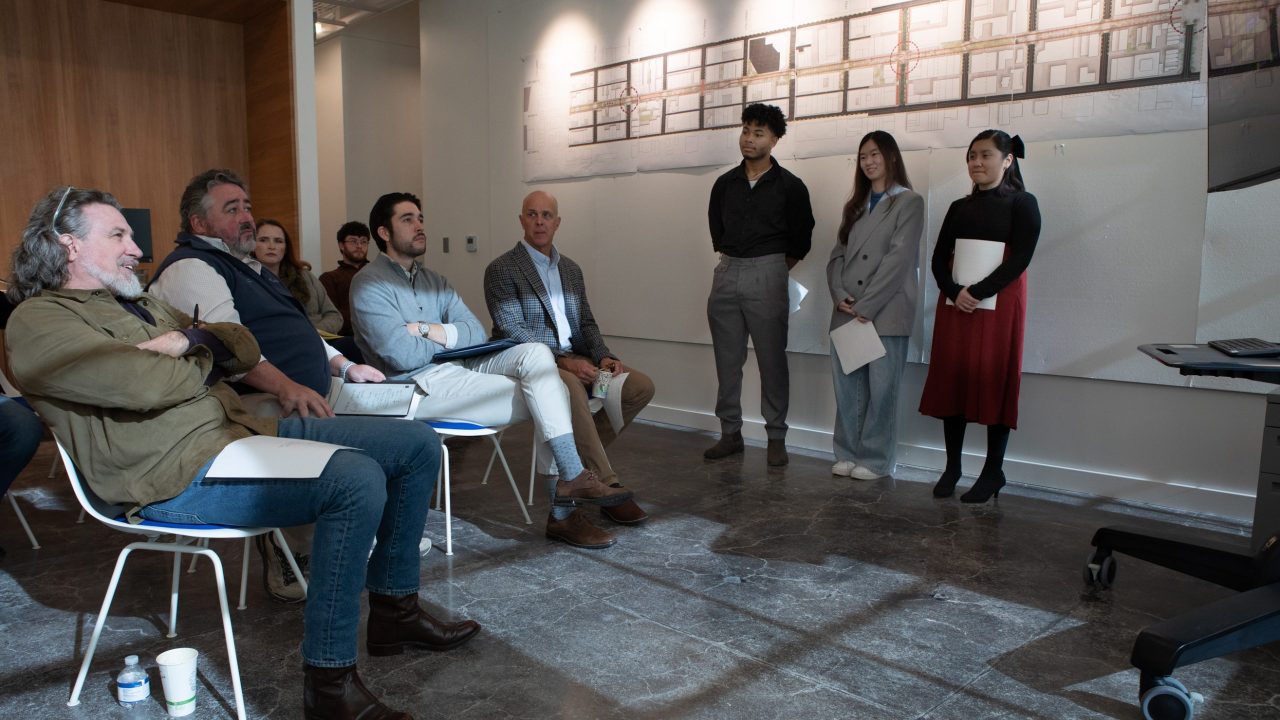Urban Studio Students Develop Plan to Reconnect Birmingham

What happens when the City of Birmingham receives a grant to reimagine Fourth Avenue North?
It creates an opportunity for Urban Studio students in Auburn’s School of Architecture, Planning and Landscape Architecture to exercise their creativity and reinvent what it means to the city when Fourth Avenue North thrives.
Real world work
The City of Birmingham recently received a $14.5 million grant from the US Department of Transportation to convert Fourth Avenue North, currently a one-way street, back to a two-way street. Revitalizing Fourth Avenue could provide two important benefits to the city: reconnecting neighborhoods like Smithfield to Downtown and revitalizing an important artery of the city.
This semester, the fifth-year students studied previous master plans to better understand Fourth Avenue’s importance to the city and what various constituents want to see happen to the corridor. From their studies, the students were able to define the different uses along the corridor, document the existing assets, understand the needs and constraints of developing the area and use this information to develop a creative solution.
Real world problem
Although Fourth Avenue is underdeveloped—it faces limited access to fresh food, experiences strong urban heat effects and lacks pedestrian-friendly infrastructure—it is also the heart of Birmingham’s Black Business District, a key site in the civil rights movement, and is home to contributing community spaces such as the Carver Theatre, a Post Office, several churches, The Harbert Center and Urban Studio.
Ultimately, the students were inspired by urban promenades and decided the way to energize the Fourth Avenue corridor was to implement the Complete Streets approach. Complete Streets not only provide a sense of comfort with safe traffic, pedestrian-friendly spaces and accessibility, but also opportunities for economic growth including increasing tax base, property values and revenue for the city.
I was very impressed with the quality of work presented by all of the students. It appears they are given freedom to explore within the very real confines of an existing urban environment.
Real world solutions
Through their research, they realized that creating a Complete Street can provide the economic resources to enable the city to better serve the surrounding communities. Such an approach can reconnect communities to the city in multiple ways, which also helps the city meet the grant’s requirement to reconnect Smithfield to Downtown.
At the end of the semester, the fifth-year students each defined an architectural idea and selected a project to determine if their solutions could contribute to solving some of the corridor’s problems.
Real world experience
However, fall semester at Urban Studio isn’t just about creating something useful. It’s the final opportunity for Architecture students to work on a team and create solutions for their living classroom—Birmingham.
From learning how to work with different kinds of people to interviewing stakeholders and receiving feedback on their designs, students’ time at Urban Studio introduces them to what their post-graduation lives might look like once they begin their careers.
The final presentations on their master plan and individual projects are heard by local professionals. From architects and planners to laypeople and concerned citizens, the students are able to collect a variety of feedback that will help them complete their studio thesis next semester.
Quite often, Urban Studio alumni are invited back to experience the jury process from the other side. This year, Chase King ‘17 was invited back to Urban and sat in on both fifth- and third-year juries.
“I was most impressed with the fifth-years’ overall master plan and their understanding of the numerous challenges and opportunities their master planning could impact,” King stated. “They gave a detailed and clear introduction of the city and the main areas they intended to focus on and followed up with graphic and verbal descriptions of design solutions that were easy to follow and understand.”
This year, a new juror was introduced to the process. Chris Chubb, a retired architect from Tallahassee, Florida, joined the jury.
“I was very impressed,” explained Chubb, “with the quality of work presented by all of the students. It appears they are given freedom to explore within the very real confines of an existing urban environment. The fifth-year students presented a thorough and expansive solution to some long-standing deficiencies in the organization of Birmingham’s urban fabric. They have set themselves up well for the coming semester by developing the framework within which they can present a site-specific solution geared towards improving the overall experience of living and working in Birmingham.”
Participating in the Urban Studio program offers students the opportunity to engage with real-world challenges while honing their design and problem-solving skills. By working directly with communities, students not only enhance their professional development but also create meaningful, lasting impacts on urban environments. This unique blend of education, collaboration and civic engagement prepares future architects to lead with empathy, creativity and a commitment to sustainable change.
See more in:
Alumni, Alumni & Stakeholders, Alumni Engagement, Industry Engagement, Student Experience, Urban Studio
Related people:
Alex Krumdieck, Jennifer Cloe

